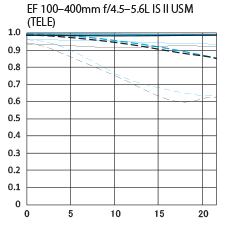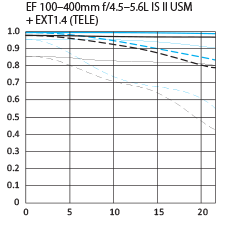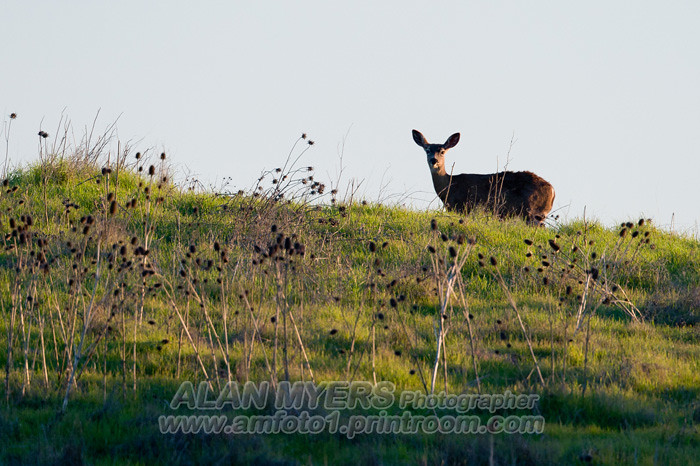Teleconverter usage question
Feb 21, 2017 12:41:47 #
CHG_CANON wrote:
You're missing the fact that you'd lose autofocus ... (show quote)
in the old days we did fine with manual focus. there was an article in outdoor photography, ware the photographer stacked as many as 4 tc's and got good images , and they were in focus.
I mount two 2x tc's on my pentax 645D with a 400mm lens. manual focus and good images.also 2000mm with crop factor, that's 40x.
Feb 21, 2017 12:59:24 #
jackpi
Loc: Southwest Ohio
akfishguide wrote:
I was just up at a Wildlife Mgt. area and there wa... (show quote)
Non-zoom lenses work much better with teleconverters than zoom lenses. You will be disappointed with the results. You are better off saving up for a Tamron or Sigma 150-600mm zoom lens.
Feb 21, 2017 13:34:12 #
jackpi wrote:
You might be disappointed, but you cannot be certain how someone else will react.Non-zoom lenses work much better with teleconverters than zoom lenses. You will be disappointed with the results. You are better off saving up for a Tamron or Sigma 150-600mm zoom lens.
Feb 21, 2017 13:40:42 #
jackpi wrote:
Non-zoom lenses work much better with teleconverters than zoom lenses. You will be disappointed with the results. You are better off saving up for a Tamron or Sigma 150-600mm zoom lens.
Depends on the zoom. Some Canon zooms such as the 100-400L work quite well with Canon extenders. I beleive Regis routinely shoots with a 100-400L MK2 + a Canon extender, and his shots are superb. Below are the Canon-published MTF charts for the 100-400L with and without the 1.4x extender, and the difference, as you can see, is quite small - perhaps 5%. I shoot with this combination, and I'm am fairly critical regarding sharpness and IQ, and I am by no means disappointed.


Feb 21, 2017 14:42:05 #
akfishguide wrote:
I was just up at a Wildlife Mgt. area and there wa... (show quote)
I'm not sure you really want to think about Sensor crop factors that way. Just learn what each lens does for you. I sometimes shoot a 4x5" view camera. Say if I use a 210mm Lens I do not even think how that compares to a 70-210mm Zoom on a 35mm SLR or DSLR. It has no meaning. To your question. You multiply the power of the tele-extenders. 2x & 1.4x = 2.8x, that is what you get with your lens; 2.8x 70-200mm = 196-560mm. If you want to compare for some reason your Nikon D7000 to a D810, by all means multiply again by 1.54 to get 840mm if you want to kid yourself that way. In fact stacking extenders is a bad idea, not only will there be little light getting to the sensor, but your image will likely look horrible. Your true resolving power goes down. Use one extender or the other, 1.4x or 2x only. There is never a substitute for the correct equipment. I'm not saying you don't have choices.
Feb 21, 2017 15:27:46 #
amfoto1
Loc: San Jose, Calif. USA
akfishguide wrote:
I was just up at a Wildlife Mgt. area and there wa... (show quote)
The problem is image quality...

The above image was shot with a Canon 500mm f4 lens with 1.4X and 2X teleconverters stacked behind it, all on a Canon APS-C camera. So that's 500mm x 1.4 x 2 x 1.6 = 2240mm full frame equivalent.
But it's hardly worth doing... I won't print the above image any larger than 5X7, since IQ is relatively poor.
For one, it's hard to get a steady shot... even using a sturdy Gitzo Series 3 tripod and with Canon's helpful image stabilization.
The added optics of the teleconverters reduce the amount of light passing through the combination of lens. An f4 lens becomes an effective f5.6 when you add a 1.4X (one stop loss), or an effective f8 with a 2X (two stops). With both TCs installed, it becomes an effective f11 (three stops lost). As a result... no autofocus. I shot with manual focus lenses for a couple decades and was pretty darned good at it. But modern autofocus used right is faster and more accurate than I ever was doing it manually!
Plus, "effective f11" makes for a pretty dim viewfinder to try to manually focus. Not to mention that modern DSLRs aren't very "manual focus friendly". They lack the focus assist features of vintages cameras, such as split image rangefinders and micro-diaprisms. And, modern viewfinders typically aren't as large and bright as some vintage, manual focus cameras offered. OTOH, Live View with Exposure Simulation might help... Focus Peaking would too, if a camera has it.
Teleconverters also inevitably rob some degree of image quality. Just how much varies a lot depending upon the quality of the lens and teleconverter, plus how well they complement each other. Even "the best" 1.4X will likely "cost" about 5 or 10% of resolution. A stronger 2X probably costs about 10 to 20%. There also might be some vignetting and/or increase in chromatic aberration, or reduction of contrast and color saturation. Used with an exceptionally high quality lens, those losses will typically be less noticeable than with a more standard quality lens. Prime lenses typically work much better with teleconverters, than more optically complex zooms do. Stopping down from wide open also sometimes helps, but forces one to use slower shutter speeds that are harder to hold steady and/or higher ISO that make for lower image quality.
An APS-C camera is often better choice than full frame. Sort of a "free teleconverter" (1.5X on Nikon, 1.6X on Canon). By "free" I mean there's no loss of light and IQ, such as there is to the optics of an actual teleconverter. Crop sensor cameras typically "put more pixels on target" with any given focal length and distance, than cropping down a full frame image to that same size. For example, your D7200 is a 24MP DX camera. And your D810 is 36MP FX. But if you use the D810 in DX mode (or do an equivalent crop of an FX image), what's left is about 15MP. So for telephoto work, the D7200 is a better choice, with about 60% more resolution in the DX format.
Finally, regardless the quality of the gear you are using, the farther away the subject, the more atmosphere you're shooting through, and the greater the loss of IQ to haze or heat waves or other factors out of your control. Best conditions would probably be a cool, moderately overcast day right after a rain shower has cleared the air.... But, more often than not, images shot through a lot of atmosphere will be significantly lower quality.
Simply getting closer to your subjects will nearly always give better results. Sometimes subjects are just too far away to be practical to photograph. That's a good time to stop shooting, eat a snack, relax and enjoy the show.
Feb 21, 2017 15:43:24 #
amfoto1
Loc: San Jose, Calif. USA
jackpi wrote:
...You are better off saving up for a Tamron or Sigma 150-600mm zoom lens.
Or a Nikkor 200-500mm f5.6. That zoom costs about the same as the Tamron 150-600 G2, I think... and is less expensive than the Sigma 15-600 "Sport".
I haven't used it personally, but from what I've heard and read it has better IQ at 500mm than any of the third party lenses.
Feb 21, 2017 21:14:12 #
Howard5252 wrote:
Here's the right answer. You take your setup > walk outside of your house > take some picture of distant objects > look at your results. That's it. Skip the math.
You forgot his next step, > if using more than one tele-Extender; press the Delete button.

Feb 21, 2017 21:36:07 #
Thanks everybody for your replies. I actually did put the combination together with the 1.4X connected to the 70-200mm and next in line was the 2X. I used my D810, a RRS tripod, a cable release and took about 150 photos. Some were very soft because I started with an ISO of 64 and slowly worked it up to about 2500 so I could shoot using faster speeds as the birds were all on the move and the wind was blowing. As I looked at the photos I actually found the Blue Heron I could not see with my naked eye and did not notice till I saw the photos. Not something I would do all the time, but thought I would try it. For me that is what photography is about. Taking photos and trying new things. Enjoy your photography.
Feb 21, 2017 22:33:17 #
akfishguide wrote:
Yes, and advice given should depend on what you're trying to accomplish. I am fairly sure that using your combination isn't going to result in any 3' x 2' prints hanging at the Louvre. On the other hand, if it gets you pictures that you want, then that should be good enough.Thanks everybody for your replies. I actually did... (show quote)
A few years ago, back when I was a Canon user, I purchased a used older Kenko doubler. I was told that this would reduce the effective f-stop of my lens to the point that my Canon Rebel XT would be unable to focus. However, this older doubler didn't report itself, so the Rebel didn't know it couldn't focus - so it just got to work and successfully focused every time I used it. The images were not great, but I wasn't looking for great ... I was happy with adequate. For example, one time I used it to photograph the builder's plate on the side of a steam locomotive and determine who built it when. I could barely make out the writing, but I got what I wanted. From other experiments I did, I really doubt that cropping away 3/4-th of an image taken without the doubler would have given me a legible image of the plate.
Last autumn, my family spent an afternoon at a local county park. As we were getting ready to leave, my wife could just barely see some kind of waterfowl through her binoculars. I got out my budget-basement birding kit - a K-mount 70-300mm lens mounted on a 4.65-crop-factor Q-mount MILC. I had to jack the ISO setting up to an uncomfortable 1600, but I did get an image. Again, nothing for the Louvre, but my wife could see now see what the bird looked like and determine that it was unfamiliar to her. However, when she sent it to a friend, that friend responded "that is a good view of a double-crested cormorant". Not truly a good view, but an adequate view, and that gave us much more than we would have had without it.
If you want to reply, then register here. Registration is free and your account is created instantly, so you can post right away.




